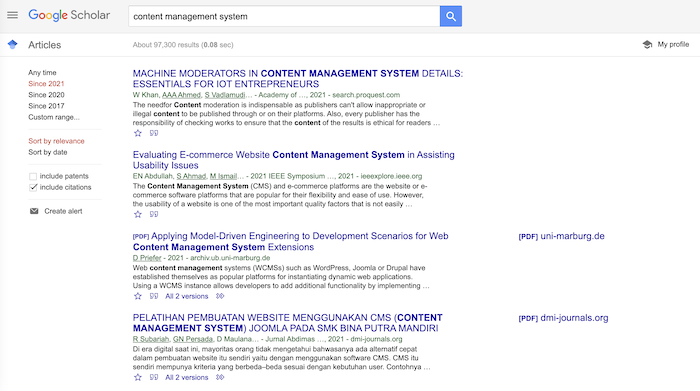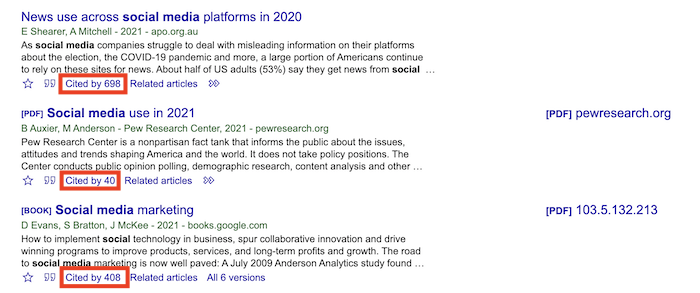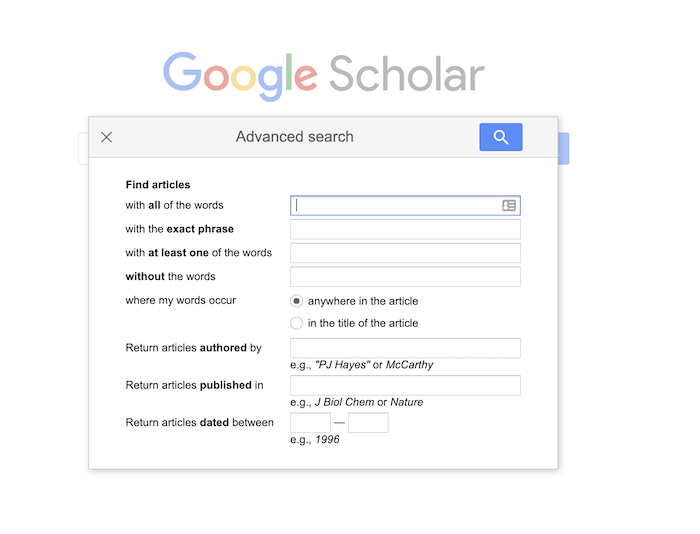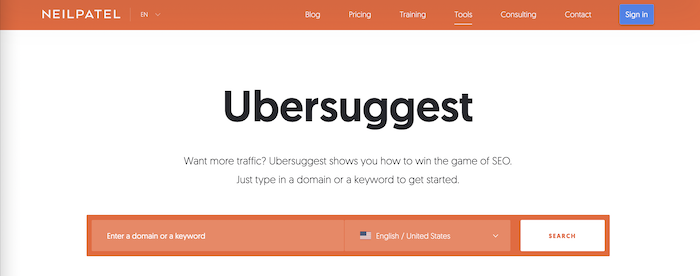Looking for a new way to research or find content ideas for your marketing content? You may have heard of Google Scholar but aren’t sure if it’s the right tool for what you need.
Google Scholar is a search engine for scholarly literature at major academic publishers and university presses that lets you find articles or citations on the topic of your choice.
Google Scholar is a great resource for finding articles on topics related to your niche and adding them to Google Scholar’s library.
Anyone can use this tool, such as marketers, academics, or anyone who wants to do research. All you need is an idea of what you’re looking for and a Google account.
Well-researched content helps build audience trust and positions you as a leader in your industry.
Creating content can be one of the most effective ways to promote your business. Not to mention, it costs 62 percent less than traditional marketing and can triple the number of leads you bring in.
In this blog post, we’ll discuss strategies for using Google Scholar to find marketing content ideas and research, plus tips to be successful.
Let’s get started!
How Does Google Scholar Work?
Google Scholar ranks documents based on the number of times an article has been viewed, printed, or downloaded within a set period of time (usually around one year).
Similar to Google search results, the most popular or most used topics are shown first in Google Scholar results.
Google Scholar’s aim is to rank documents the way researchers would: based on relevance and popularity.
This ranking system also means searchers can find relevant content more quickly.
Documents are added to Google Scholar’s library when publishers submit them to the Google Scholar Metadata Program. From there, documents are indexed, ranked, and made available to searchers in search results.
There is no limit on the number of documents that can be added to Google Scholar’s library—it all depends on how many publishers are participating.
This makes it easy for marketers and researchers alike to find a wide range of relevant content ideas or research topics.
8 Strategies for Using Google Scholar for Content Ideas
Google Scholar is beneficial to searchers because it allows marketers and researchers easy access to scholarly literature like academic journal papers. You can find content ideas on Google Scholar by searching for keywords related to your industry, brand, or topic.
No matter if you’re looking for news articles on digital marketing trends in healthcare, Google Scholar can help you get high-quality search results.
If you want to learn how to use Google Scholar successfully for your marketing research, follow the steps below.
1. Search by Year to Find Trending Topics
Google Scholar’s advanced search option can help you find the most relevant research papers by year.
You can also use this feature if you’re looking for more recent content on a topic and want to avoid older articles that don’t reflect current trends in your industry.
For example, let’s say your company is interested in social media marketing best practices, but you want to keep your results modern. Google Scholar can help you narrow down research topics to a specific date range.
To narrow your search down by date, you use the “Since Year” option to show only recently published papers, sorted by relevance.
You can also use the “Sort By Date” option to show just the new additions, sorted by their publish date.
Using these features can help you find the most up-to-date resources on your topic or find out what competitors are talking about right now.
2. Explore Related Articles to a Certain Topic
Google Scholar’s Related Articles option allows you to explore articles similar to ones you’ve already read, which can help you generate more content ideas.
To use this feature, simply click the Related Articles link at the bottom of an article on your results page.

For example, if you search “content management system” and find a great resource about WordPress, you can follow it up with related articles for WordPress, Drupal, and Joomla.
This can also be helpful if you find an article about your main keyword but want to know more about what other related keywords are being searched for most often.
For example, if you search for “content management system” in Google Scholar right now (because Google Scholar searches popularly-used terms), you get the following results:

These related articles give you a great starting point to continue your research and create stronger content topics.
3. Explore the Most Popular Articles and Publications
Google Scholar lets you browse the top 100 publications in multiple languages, ordered by five-year h-index and h-median metrics.
This feature allows you to see which articles in a publication were cited most often and by who.
You can also click the h-index number to see the article and citation metrics. The h-index is a number that represents the highest number of papers in the publication that have been cited at least that many times.
The h-median metric is the median of the citation counts in its h-core. Articles in the top 50 percent of citations count towards this metric.
By exploring popular publications to see what topics they cover and what authors are most cited, you can find content ideas for your own blog topics.
4. Follow the Citations for Additional Ideas
Using the Cited By option on Google Scholar leads you to other relevant search results within the Scholar database.
Cited By shows you how many times the result has been cited by other journals.

By following these citations, you can learn more about your topic and improve the quality of your research or topics.
For example, if you want to write about the latest trends in SEO, it would be helpful to know what the most reputable sources on this topic are. If you find an article that’s been cited 500 times, you’ll know you’re reading something with merit.
Finding articles by the number of citations they have received is a great way to find high-quality content ideas.
Just be careful not to limit yourself too much, or you might miss out on some important information!
5. Narrow Your Results by Field
Google Scholar’s Advanced Search option lets you limit results to specific fields of study.
Fields are controlled by the Advanced Scholar Search function, which lets users input keywords, phrases, and places where they occur. You can also segment your results by authors, publishers, and dates.
This feature is great for marketers who want to focus on certain areas of their industry.

For example, someone who wants to write about the food and beverage industry would enter “food and beverage” in the keyword search box. They would also input “food industry” in the phrase search box.
This keeps their results limited to articles about food and beverage within the food industry, instead of all scholarly articles found by Google Scholar’s search engine.
6. Use Keyword Research to Inform Your Search
Many Google Scholar articles have their keywords listed at the beginning of the result.
You can use these keywords as inspiration for content ideas. Or, if you already have a keyword in mind, you can get ideas for others from the results given. This is a great way to find related concepts to improve the quality of your article.
Not sure how to find relevant keywords for your article? Use Ubersuggest to inform your search!

The more relevant satellite keywords you add, the more likely is it that Google Scholar will return good results for your topic.
You can also use this method when writing blog posts or articles so you can quickly look up keywords and see related concepts at a glance.
Doing this research in advance allows you to produce higher-quality content with well-researched sources and information.
7. Find Industry and Competitor Topics
One strategy for using Google Scholar to find content ideas is to look at what your competitors and other industry leaders are doing.
For example, if you’re in the business of selling hats, and another company just published an article ranking high on Google Scholar about hat trends this year, that might be a good incentive to write something similar yourself.
Alternatively, you could use Google Scholar results to write about topics that are relevant to your industry.
For example, if an author or influencer in the online marketing space has recently published a book on email marketing strategy, that would be a good inspiration for potential blog post content ideas since it’s topical and directly related to your audience.
Lastly, you can use Google Scholar to find ideas for your product or service. If you’re a company that sells software, why not google scholar “software marketing tips” and see what comes up? You may find new ideas that haven’t crossed your desk before.
8. Use Google Scholar to Expand Your Customer Base
The last Google Scholar strategy to consider is using it to find potential customers.
If you are a company that specializes in the B2B space, you can try searching for topics relevant to your industry and see who’s writing about them. This can open your eyes to new people in the industry you might want to do business with.
You may also find relevant searches that focus on market research or lead generation strategies for companies within your niche. These could turn into potential prospects or partnerships in the future.
Even if you don’t get any new leads, you’ll still be able to gather in-depth knowledge about how other players in your industry are creating and interacting with content.
This can give you new ideas for content topics of your own.
Frequently Asked Questions About Google Scholar
How Do You Search on Google Scholar?
To search on Google Scholar, simply enter your keywords in the search bar and click the magnifying glass icon.
How Do I Search Google Scholar for Journals?
Google Scholar makes journal articles easier to find and access than ever before. To search Google Scholar for journals, enter your keywords in the search bar followed by “journal” or “JSTOR.” For example, if I wanted to look at marketing books, I would enter: marketing + JSTOR.
Is Google Scholar Good for Research?
Google Scholar is a great tool for research because it allows you to segment searches by time, publication, or author.
Is Google Scholar Free?
Yes, all of the information on Google Scholar is completely open access for anyone to see.
How Do I Activate Google Scholar?
What Is the Best Way to Use Google Scholar?
You can use Google Scholar for marketing research, content topic creation, scholarly research, and more.
Google Scholar Guide Conclusion
One of the main reasons Google Scholar is so popular among marketers and researchers is because it’s easy to use. All you need is an idea, and Google Scholar will do the rest for you.
When using Google Scholar search, be sure to enter all of your known keywords, not just one or two words. For example, if you are searching “marketing articles,” Google Scholar would return everything related to marketing, including articles on marketing psychology, which may be less useful to you than the articles about online marketing content strategy.
Once you have the results you’re looking for, keep refining your search and exploring other citations or results.
Google Scholar is a great way for marketers to inform their content ideas and create innovative articles that people enjoy reading.
How have you used Google Scholar in your content marketing strategy?

See How My Agency Can Drive Massive Amounts of Traffic to Your Website
- SEO – unlock massive amounts of SEO traffic. See real results.
- Content Marketing – our team creates epic content that will get shared, get links, and attract traffic.
- Paid Media – effective paid strategies with clear ROI.